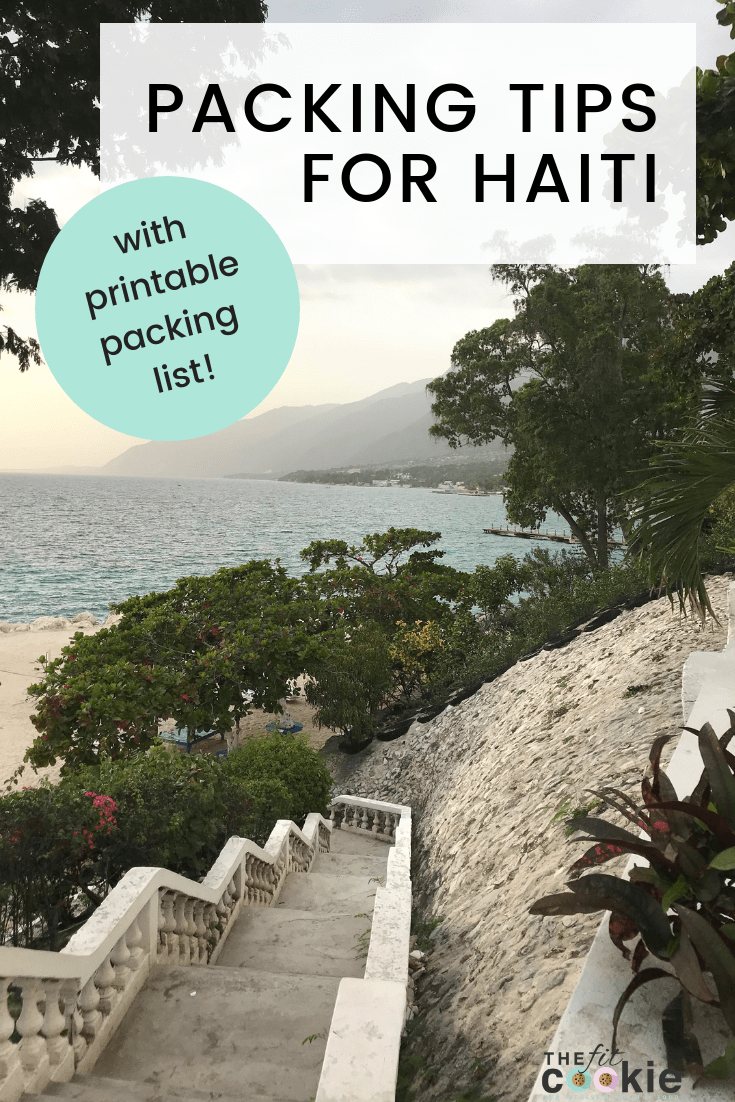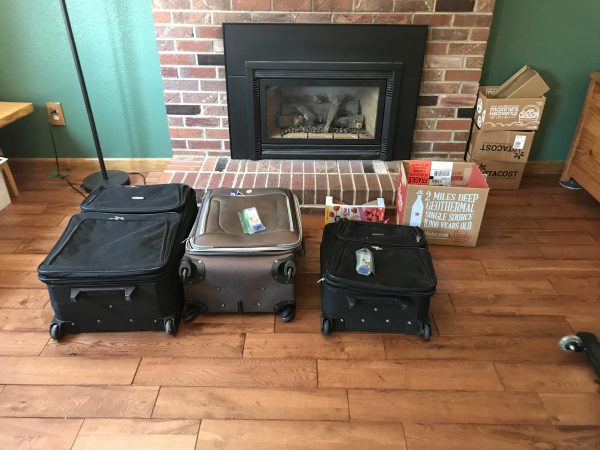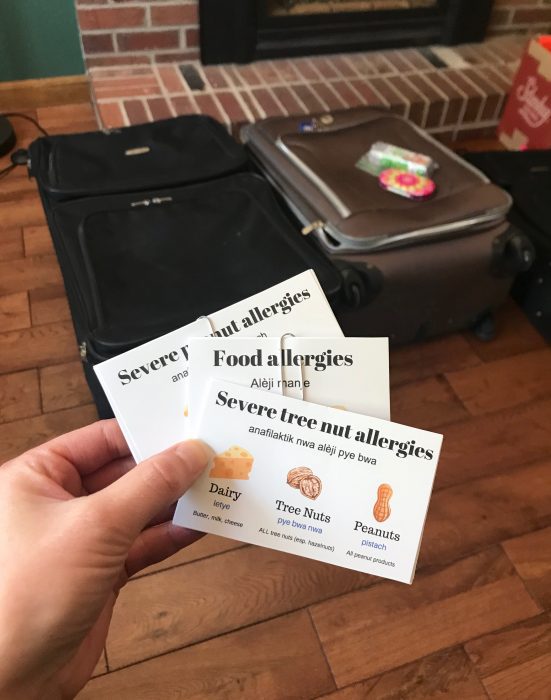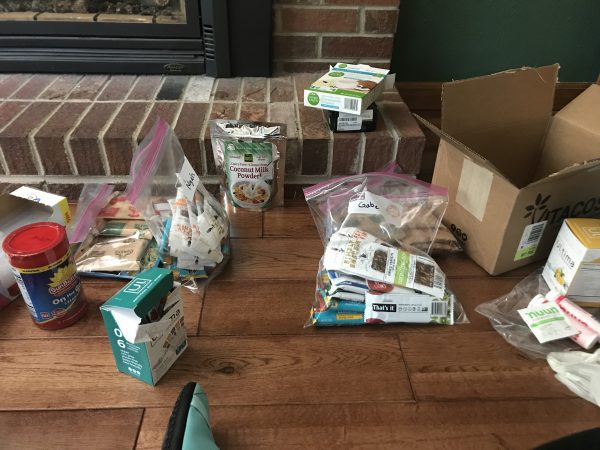Planning a trip to Haiti for missions work? Here are some packing tips and essentials to bring, as well as some tips for people with food allergies (our post includes a printable packing list!)

A couple months ago, we took a trip to Haiti to help children sponsored through The Mission Haiti get ready for their school year. It was such a great experience helping people in the community in Bercy, we want to go back again.
I had been planning on getting this post up a little earlier, but different things have come up so it was delayed a bit. But here it is finally! Better late than never in the blogging world, I always say 😉
This list and these tips are mostly for people who are going out into the communities, cities, and countryside in Haiti. This probably isn’t the list for you if you’re just visiting a resort on the beach.
If you travel with a group, they will likely have their own packing list for you to take, but here are a few things that I recommend with some links to the actual products we took with us and loved.
Please note that this list may not be comprehensive based on your individual needs and type of trip you’re taking. Make sure to check out other packing lists online as well.
Shots and vaccines
Please note, this does not replace the advice of your doctor and should not be considered medical advice! Always consult your physician about what vaccines you will need for travel to Haiti.
- Typhoid vaccine (shots or pills): if you’re doing a shot, it usually needs to be done a couple months before entering the country
- Polio booster shot (if your doctor thinks you need one)
- Milaria pills
- Ask your doctor about how to prevent cholera and zika (the CDC website has good info on this as well).
Haiti doesn’t require these shots (at least at the time of writing this), but they are highly recommended anyway.
For adults who haven’t had their initial polio vaccine in a while, it’s a good idea to get a polio booster shot before traveling to third world countries (ask your doctor or nurse if you need one).


Essentials packing items for Haiti
- Bug spray OR bug wipes with at least 20% DEET
- Natural bug spray: we used the NOW Bug Ban, one of our favorite natural bug sprays
- Hand sanitizer (liquid): we got travel bottles of the lavender and aloe Everyone hand sanitizer from Walmart that worked great
- Hand sanitizer wipes (so handy!!): we used the natural Everyone hand sanitizer wipes
- Flashlights and extra batteries
- Hydrocortisone cream
- After Bite or Benadryl bug bite treatment
- Chewable Benadryl and/or Zyrtec (for allergies)
- Your prescription medications
- Reusable water bottle: preferably one that’s insulated to keep your water cold (we used Takeya bottles)
- Shower sandals: cheap plastic or foam flip flops work!
- Comfortable walking shoes: closed toe if you don’t want dirt and prickles getting into your shoes easily
- Sandals
- Electrolytes: we took travel packs of Ultima powder and Nuun hydration tablets
- Passport (of course!) or other necessary documentation: make sure that you have a safe place to keep this where you’re staying. I used a neck passport holder when we were going through airports since I had to hold onto 3 sets of passports, boarding passes, etc.
- Cash: most places take American money so we never had to exchange money
- Backpack, waist pack, or traveler’s stash pack
- Food allergy cards if you have severe food allergies: we made our own food allergy cards using Canva and Google translate
- Medical alert cards or medical alert jewelry if you have medical concerns (we got RoadID medical alert bracelets for our kids)
- Snacks
- Tylenol or other over the counter pain reliever
If you have severe food allergies like my kids do, you need to print up some food allergy cards in English and translated to the local language (in Haiti it’s French and Haitian Creole). It doesn’t hurt to add pictures of the foods as well. Make sure you print several copies of these cards and carry them with you everywhere!

Most of the things that we brought with us that we didn’t need to take home (like Benadryl, Tylenol, bug spray, electrolytes, snack bars, etc.), we left for the people at the orphanage. Our bags were lighter on the way home, and we helped them out. Win win!
Notes on footwear
You’ll want to bring both closed toe shoes walking shoes, comfortable walking sandals, and shower sandals. I am a stickler about wearing shower sandals in any shared shower, even in the US.
My son decided not to wear sandals in the shower in Haiti, and he got a plantar wart on his toe from the virus getting into the place where he had a blister on his toe. It’s certainly not life threatening, but it’s inconvenient and treatments can be painful, so avoiding that from the beginning is better.
I used sandals most of the time while we were walking around in Haiti, but dirt got on my feet and I got blisters on my feet from new sandals that weren’t broke in. Not ideal. We saw broken glass, nails, thorns, and needles on the roads and paths (my son got poked by some thorns in his feet), so I decided that the next time we go, I’ll wear my tennis shoes while walking around instead of sandals.
Notes on Bug repellent
You’ll want to use a bug repellent with at least 20% DEET. Use DEET during the day, then shower it off at night and spray on natural bug spray to sleep in (we slept under mosquito nets but I still wanted some natural bug spray on).
The public health nurse that did our typhoid shots told us to never sleep with DEET bug spray on your skin! She told me that we needed to wash it off every night and reapply it every morning.
That DEET bug spray stuff will corrode plastic, and it’s normally not something I’d want on my skin at all, but if I had to choose between DEET and diseases carried by mosquitos, I choose the DEET. It’s heavy duty and you need it if you’re traveling in a third world country with lots of mosquitos.
I didn’t get too many bug bites until Friday. It rained on Thursday night, and on Friday the mosquitoes were super active. Even with the 30% DEET bug wipes I used, I got mosquito bites on Friday, even inside the Port au Prince airport.
Bug repellent wipes are really nice to have on hand in addition to bug spray. I carried a travel bug spray with me in my backpack everywhere, and bug repellent wipes. The wipes are easy to use, you can get the wipes where you need it without worrying about spray not covering evenly or getting in places you don’t want it (like your eyes or on your watch).
Notes on food and snacks
It’s a good idea to bring individually packaged snacks and foods with you. We helped cook meals at the orphanage, and they shopped for us with food allergies in mind, but we brought plenty of food in case we needed to skip the foods that were made due to food allergies.
We also divided our foods up evenly between our 3 checked bags in case we lost a bag somewhere, then gathered up all the food again once we reached our destination. We planned our snacks for outings, and made sure that snacks and foods were double bagged in our rooms to keep bugs out.
Check out the TSA list of foods that are allowed and aren’t allowed for international travel
Fresh fruits and seeds are not allowed in international travel (dried fruit is okay), so here’s what we brought:
- Jerky or protein bars: we brought Simply Snackin’ bars
- Energy/snack bars: we brought That’s It dried fruit bars, Enjoy Life bars, and other snack bars that fit all of our allergies so we could share them
- Instant coffee: I love the Mount Hagen brand, they have travel packets. This saved my butt! I was so tired from traveling and the heat, I needed that caffeine pick-me-up for real. I had heard that the coffee wasn’t great at the place we stayed, so I’m glad I brought my own.
- Coffee creamer sticks: I used the Simple Truth coconut creamer packets, which I used regularly at home already and love
- Collagen powder or protein powder: in the morning, I’d mix some collagen powder with my instant coffee for a little extra protein
- Shaker bottle: for your instant coffee or protein powder
- Milk powder: we brought coconut milk powder but didn’t end up using it
- Instant oatmeal packets
- SunButter to-go packs

Since I have food allergies, I brought my own instant coffee, and I brought my own travel packs of coconut milk coffee creamer. I made sure that I had plenty of both, and I brought a Blender Bottle with me to mix my coffee with.
Make sure that any food you bring is double bagged. The place we stayed was a good place, but it was still open to the outside, so there were plenty of bugs around. And some cockroaches. So if you bring food, make sure you bring travel packs or bags to seal them up in before and after they are opened.
One of the things to note about food is that we didn’t eat our snacks around people much. There are many people in Haiti who have very little to eat, so we made sure if we were eating snacks, we weren’t eating in front of people who may not have even eaten that day.
Non-essential items that are a great idea to bring
- Cooling towel: we used the Frogg Toggs mini cooling towels and they were the perfect size)
- Mini fan or misting fans: we cooled off with fans on our down time since the orphanage we stayed at had no AC. We took the little O2 misting carabiner fans with us and loved them
- Charging banks (access to electricity isn’t always guaranteed, even at the airport…)
- Journal or notebook for writing your experiences
- Camera or camera phone
- Battery operated fans: since we didn’t have AC, we used small fans at night. We used these small clip fans to attach to our beds at night, but we ran out of battery later in the week, so I’d recommend bringing extra batteries
- Spare water bottle: in case you lose one or break one. We brought several Takeya bottles that have good insulation and are double walled so they don’t condensate on the outside when it’s hot
- Ear plugs: it was hard for us to sleep with dogs barking and roosters crowing, so we had to sleep with ear plugs.
- International calling or data plan for your phone
*NOTE: make sure that you’re checking out other packing lists as well to see what other people recommend that I might have missed!*
Check out the CDC’s resource page for traveling to Haiti – it’s super helpful!
Cleaning luggage
When we got back from Haiti, I took some disinfecting wipes and wiped down the hard plastic parts of our luggage, then used a homemade spray to spray all over the inside and allowed them to air dry. I also vacuumed them well.
For the homemade luggage spray, I used rubbing alcohol, distilled water, and a few drops of essential oils (tea tree, grapefruit seed, and rosemary oils). Since we had used our bags to carry things around the town we were in, our bags were in need of a good cleaning when we got back.
Hard side luggage is a great idea since you can easily wipe it down with sanitizing wipes periodically and it’s so much easier to keep clean!
Printable travel/packing list for Haiti
Sign up for our weekly email newsletter through Grow (or sign into an existing Grow account) and receive our free printable packing list for Haiti!


Sarah Jane Parker is the founder, recipe creator, and photographer behind The Fit Cookie. She’s a food allergy mom and healthy living blogger based in Wyoming. Sarah is also an ACSM Certified Personal Trainer, ACE Certified Health Coach, Revolution Running certified running coach, and an ACE Certified Fitness Nutrition Specialist

There are a few things on this packing list that I’d otherwise have left at home. It’s a handy start to ensuring everything needed goes into the suitcase!
Thanks Stuart!